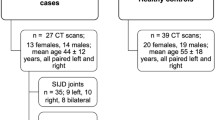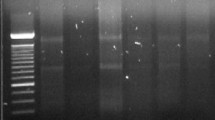Abstract
Iliac and sacral articular cartilage of 25 human sacroiliac joints (1–93 years) are examined by light microscopy and immunohistochemistry in order to gain further insight into the nature and progress of degenerative changes appearing during aging. These changes can already be seen in younger adults as compared to cartilage degeneration known in other diarthrodial joints. Structural differences between sacral and iliac cartilage can already be observed in the infant: the sacral auricular facet is covered with a hyaline articular cartilage, reaching 4 mm in thickness in the adult and staining intensely blue with alcian blue at pH1. Iliac cartilage of the newborn is composed of a dense fibrillar network of thick collagen bundles, crossing each other at approximately right angles. A faint staining with alcian blue suggests a low content of acidic glycosaminoglycans. In the adult, iliac cartilage becomes hyaline and its maximal thickness reaches 1–2 mm. Both articular facets exhibit morphological changes during aging that are more pronounced in the iliac cartilage and resemble osteoarthritic degeneration; the staining pattern of the extracellular matrix becomes inhomogenous, chondrocytes are arranged in clusters and the articular surface develops superficial irregularities and fissures. Sometimes fibrous tissue fills up these defects. Nevertheless, large areas of iliac cartilage remain hyaline in nature. Sacral articular cartilage often remains largely unaltered until old age. The sacral subchondral bone plate is usually thin and shows spongiosa trabeculae inserted at right angles, suggesting a perpendicular load on the articular facet. Iliac subchondral spongiosa shows no definite alignment and joins the thickened subchondral bone plate in an oblique direction. The iliac cartilage therefore seems to be stressed predominantly by shearing forces, arising from the changing monopodal support of the pelvis during locomotion. The subchondral bone plate on both the iliac and sacral auricular facet is penetrated by blood vessels that come into close contact with the overlying articular cartilage. These vessels may contribute to the high incidence of rheumatoid and inflammatory diseases in the human sacroiliac joint. Immunolabelling with an antibody against type II collagen reveals a diminished immunoreactivity in the upper half of adult sacral cartilage and only a faint and irregular labelling in the iliac cartilage. Type I collagen can be detected in a superficial layer on the sacral articular surface and around chondrocyte clusters in iliac cartilage, as in dedifferentiating chondrocytes during the development of osteoarthritis.
Similar content being viewed by others
Author information
Authors and Affiliations
Additional information
Accepted: 22 April 1998
Rights and permissions
About this article
Cite this article
Kampen, W., Tillmann, B. Age-related changes in the articular cartilage of human sacroiliac joint. Anat Embryol 198, 505–513 (1998). https://doi.org/10.1007/s004290050200
Issue Date:
DOI: https://doi.org/10.1007/s004290050200




